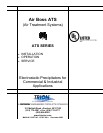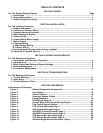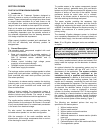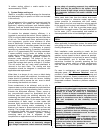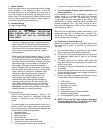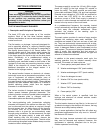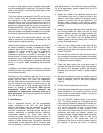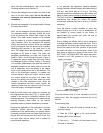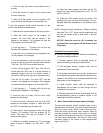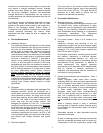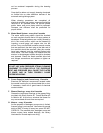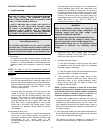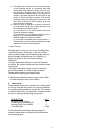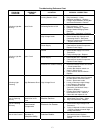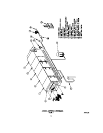
2
*A carbon section without a media section is not
recommended by TRION.
3. System Design and Layout
(Refer to, or request, submittal drawings for dimensions
and data pertaining to a specific unit that is not included
in this manual).
The arrangement of the supplied components and the
general layout of the system will vary according to
application, adjoining equipment and available space.
However, there are several basic factors pertaining to
all installations that must be considered:
To maintain the selected cleaning efficiency, it is
important to assure that the total air volume (capacity in
CFM) is uniformly distributed across the entire face area
of the unit. The metal mesh filters, perforated plate or
mist suppressors, provide some resistance to effect
even air distribution. However, since most air ducts are
designed to handle air velocities greater than the rated
velocity of the air cleaner, it is necessary to properly
transition any attached ducting. If possible, a contraction
ratio of 1 in 3 (approximately 20°) should be maintained.
If space prohibits, turning vanes, air baffles or other
means may be utilized. Ducting – where attached to the
cabinet collars – should be gasketed, caulked or
otherwise made watertight. The bottom of the air-
entering duct should be reasonably flat and sloped
toward the impinger drain pan for a length of 18 inches.
This will assure that any wash water splashback is
returned to the drain basin. The ducting and duct
connections should be designed in accordance with
applicable code requirements.
When there is a danger of rain, snow or debris being
drawn into the system with outside air, the make-up air
intake should be protected with rain louvers, hooding
and hardware cloth to prevent the rain, snow or debris
from entering the electronic air cleaner.
Some contaminants to be collected, such as oils in
vaporous state, must be condensed into particulate form
prior to entering the ionizing-collecting cells in order to
maintain the anticipated efficiency. Gases, vapors or
any non-particulate cannot be precipitated and will
therefore pass through the collecting elements. Any
condensing that takes place downstream from the air
cleaner defeats the purpose. By the same token, heavy
concentrations of water vapor, or other matter that
becomes highly conductive when condensed, must be
prevented from entering and/or condensing in the
electronic air cleaner to prevent electrical arc over and
shorting. The impinger module aids in this process and
will adequately handle light concentrations, however, it
is recommended to insulate upstream ducting
conveying warm air that is subjected to cold
temperatures on applications such as kitchen exhaust.
SAFETY NOTE:
Factory designed access to all electrically charged
high voltage components contain electrical interlocks
for the safety of operating personnel. Any additional
access that may be provided in the system, where
there is access to high voltage, must be equipped with
such interlocks. Interlocks are readily available from
the factory.
Water wash drain lines from the cabinet drain basin
should be trapped or otherwise sealed against the
system pressure (in accordance with local codes).
Wash water to the unit must meet the volume required
for the specific unit involved, and between 35 PSIG Min.
– 50 PSIG Max. at full flow to provide proper spray
patterns from the wash nozzles. The wash water MUST
be Hot water (140
0
F recommended) and installed as
close as possible to the unit and detergent system.
NOTE: THE HOT WATER TANK IS NOT PROVIDED BY
TRION.
When applicable, the detergent system, the wash water
inlet piping and the drain lines must be protected from
freezing temperatures.
Each installation varies according to needs, but the
water wash control must be located indoors, out of the
weather, and as closed to the air cleaner as practical.
Ideal mounting height is at eye level for ease in reading
the instrumentation, and to facilitate service. The
instructions furnished for manually operating the fire
extinguishing system shall be posted conspicuously
near the control in the kitchen or well-occupied work
area.
For ease in maintenance and component removal,
adequate space, 39” Minimum Required, must be
provided in front of all access doors, motors, pump and
accessory equipment. Special consideration should be
given in this respect for installations where the unit is
suspended overhead. Catwalks or platforms should be
provided.
CAUTION
In addition to the above space requirement, installation
of the Model ATS in NFPA applications shall have a
clearance of at least 18 inches to a combustible
material, 3 inches to limited combustible material, and
0 inches to noncombustible material. Any reduction in
clearance or exceptions must be in compliance with
NFPA and acceptable to the Authority Having
Jurisdiction.
****WARNING****
Fire Suppression Systems
Extreme caution should be exercised when this unit is
installed in applications that are collecting volatile or
potentially flammable contaminates such as cooking
grease and petroleum based oils.
Trion strongly recommends a fire suppression system
be installed in the ductwork and on the Model ATS in
cases where these contaminates are collected on the
cell plates and collect on the attached ductwork.
Contact the factory for questions or concerns
regarding a fire suppression system.



